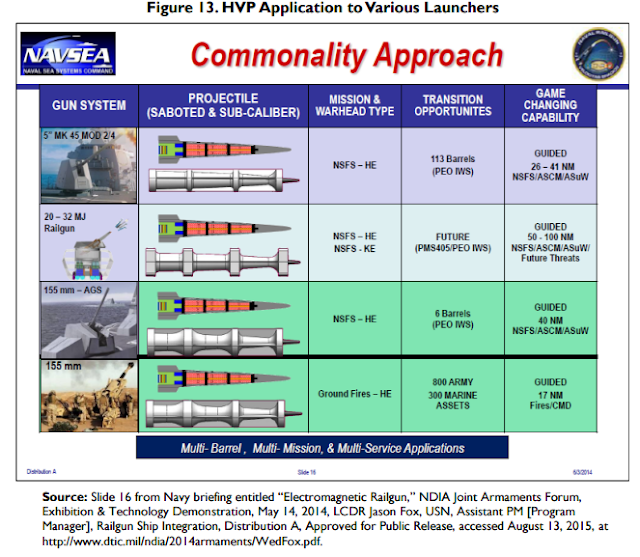US Army develop 155mm shells that will deliver an EMP pulse
by noreply@blogger.com (brian wang) from NextBigFuture.com on (#29156)
The US Army is developing an innovative, cost-effective, munitions-based electronics systems that can deliver non-destructive, non-kinetic RF effects against a wide range of electronics, critical infrastructure, and computer-based systems.
This will probably be combined with hypervelocity projectile (HVP) technology to provide extra range.
HVP is 24 inches long and weighs 28 pounds, including a 15-pound payload. The total length and weight of an HVP launch package, BAE Systems states, is 26 inches and 40 pounds. BAE states that the maximum rate of fire for HVP is 20 rounds per minute from a Mk 45 5-inch gun, 10 rounds per minute from the 155mm gun on DDG-1000 class destroyers (called the Advanced Gun System, or AGS), and 6 rounds per minute from EMRG. HVP's firing range, BAE Systems states, is more than 40 nautical miles (when fired from a Mk 45 Mod 2 5-inch gun), more than 50 nautical miles (Mk 45 Mod 4 5-inch gun), more than 70 nautical miles (155mm gun on DDG-1000 class destroyers).


Extensive use of wireless RF networking for critical infrastructure and communications systems provides an alternative attack vector for the neutralization of an adversarys underlying industrial, civil, and communications infrastructure without the destruction of the hardware associated with those systems. Advances in munitions-based microelectronics and power technologies make possible the implementation of non-kinetic cyber and electromagnetic " or electronic warfare (EW) " attacks that could be delivered via artillery launched munitions. The precision delivery of the non-kinetic effects (NKE) electronics payload close to the target allows low power operation which limits the geographical extent of impacted systems, and reduces the overall impact on the electromagnetic spectrum.
PHASE I: Design and prototype an electronics subsystem for incorporation into a standard Army munition. The initial design will fit in a 155mm projectile, with a transition path for size reduction to allow incorporation of multiple NKE submunitions per projectile.
PHASE II: Further develop and mature the NKE prototype system. Integrate the NKE system into an appropriate munitions platform. Explore, implement and demonstrate advanced non-kinetic attack techniques. Develop test methods and evaluate the system performance in the field.
PHASE III: Finalize all aspects of the NKE and prepare for distribution. Develop a commercialization plan to transition the electronics subsystems to industry and relevant users. Private Sector Commercialization Potentials: The final NKE electronics system will support a number of commercial communications protocols. The ruggedized, hardened electronics subsystem may be transitioned to a wide variety of industrial and civil applications that call for operation in extremely harsh environments.
There are conventional missile EMP weapons already, the 155mm weapon would be smaller

Read more










This will probably be combined with hypervelocity projectile (HVP) technology to provide extra range.
HVP is 24 inches long and weighs 28 pounds, including a 15-pound payload. The total length and weight of an HVP launch package, BAE Systems states, is 26 inches and 40 pounds. BAE states that the maximum rate of fire for HVP is 20 rounds per minute from a Mk 45 5-inch gun, 10 rounds per minute from the 155mm gun on DDG-1000 class destroyers (called the Advanced Gun System, or AGS), and 6 rounds per minute from EMRG. HVP's firing range, BAE Systems states, is more than 40 nautical miles (when fired from a Mk 45 Mod 2 5-inch gun), more than 50 nautical miles (Mk 45 Mod 4 5-inch gun), more than 70 nautical miles (155mm gun on DDG-1000 class destroyers).


Extensive use of wireless RF networking for critical infrastructure and communications systems provides an alternative attack vector for the neutralization of an adversarys underlying industrial, civil, and communications infrastructure without the destruction of the hardware associated with those systems. Advances in munitions-based microelectronics and power technologies make possible the implementation of non-kinetic cyber and electromagnetic " or electronic warfare (EW) " attacks that could be delivered via artillery launched munitions. The precision delivery of the non-kinetic effects (NKE) electronics payload close to the target allows low power operation which limits the geographical extent of impacted systems, and reduces the overall impact on the electromagnetic spectrum.
PHASE I: Design and prototype an electronics subsystem for incorporation into a standard Army munition. The initial design will fit in a 155mm projectile, with a transition path for size reduction to allow incorporation of multiple NKE submunitions per projectile.
PHASE II: Further develop and mature the NKE prototype system. Integrate the NKE system into an appropriate munitions platform. Explore, implement and demonstrate advanced non-kinetic attack techniques. Develop test methods and evaluate the system performance in the field.
PHASE III: Finalize all aspects of the NKE and prepare for distribution. Develop a commercialization plan to transition the electronics subsystems to industry and relevant users. Private Sector Commercialization Potentials: The final NKE electronics system will support a number of commercial communications protocols. The ruggedized, hardened electronics subsystem may be transitioned to a wide variety of industrial and civil applications that call for operation in extremely harsh environments.
There are conventional missile EMP weapons already, the 155mm weapon would be smaller

Read more